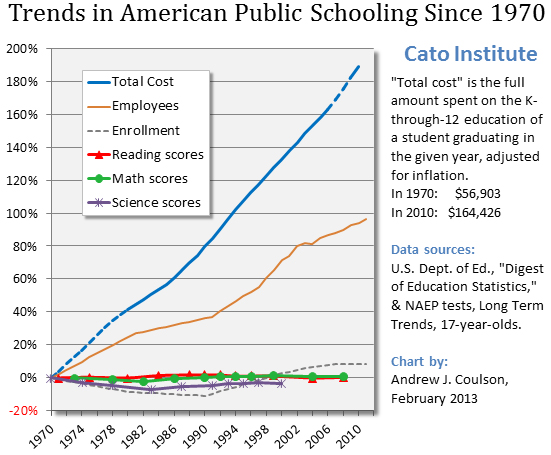Andrew Coulson links to a study in the UK. The study reports that
From the analysis of the available data, there is no clear correlation between funding and school average performance; for a given level of funding, there is significant variation in performance the calculated correlation coefficient between the two variables was less than 0.1. In our view, this suggests that the level of funding, per se, is almost irrelevant as a predictor of performance.
Having said that, the study does find a correlation between a measure of school quality and average student performance. That result would contradict the null hypothesis. However, the indicator that the researchers use for school quality is not convincingly exogenous.
the Ofsted ‘overall effectiveness’ indicator has been used as our measure of school quality. This is a combined assessment of schools’ performance that contains specific judgements on:
— pupils’ achievement and the extent to which they enjoy their learning;
— how well do learners achieve;
— pupils’ behaviour;
— the quality of teaching; and
— the effectiveness of leadership and management in embedding ambition and driving improvement.
The ‘overall effectiveness’ judgement is then made on a four-point scale: outstanding (1); good (2); satisfactory (3); and inadequate (4)
Coulson also supplies a chart demonstrating the null hypothesis in American education spending.

“Having said that, the study does find a correlation between a measure of school quality and average student performance. That result would contradict the null hypothesis.”
Not necessarily so. It could be that having a good school is an important determinant of student performance, but we have no idea as to how to spend money in such a way that could turn a bad school into a good school.
Suppose you randomly distribute an extra $1,000 per pupil (an amount reasonably similar to what marginal effects would be based on in a regression) to various principals of school districts, and asked them to spend it in a way that improves student performance – what options could they pursue?
Heck, if you gave me (a parent) an extra thousand dollars and told me to spend it in a way to measurably improve my child’s school performance, I would have a hard time doing so. I can’t imagine how difficult it would be as a principal setting policy on hundreds-to-thousands of students for which the information gap is much greater than between parent-and-child.
Let’s see. “Average student performance” is correlated with a measure that includes “pupils’ achievement” and “how well do learners achieve.”
Well, feed me nails and call me Rusty.
My wife, an inner city public high school teacher, would love to see a line showing the rise in single-parent families, and a line showing rise in student homelessness (which anecdotally i’d bet my bottom dollar on ).